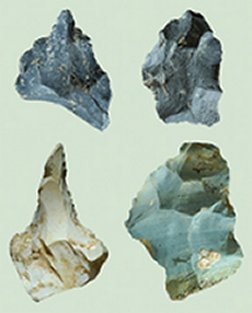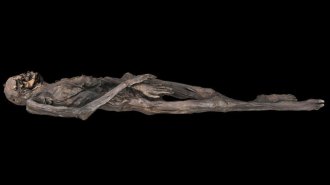Stones of Contention: Tiny Homo species tied to ancient tool tradition
New discoveries have shifted a prehistoric, island controversy from bones to stones. Simple stone tools accompanied the fossils of Homo floresiensis, the half-size human cousin that inhabited the Indonesian island of Flores around 74,000 to 12,000 years ago, but some scientists argued that those tools had been made by Homo sapiens. Now, much older tools discovered on Flores suggest that H. floresiensis individuals carried on cultural practices initiated by their island ancestors.

Stone artifacts much like those previously found among H. floresiensis fossils in Flores’ Liang Bua cave have emerged at another site on the island. The new finds date to between 840,000 and 700,000 years ago, reports a team led by Adam Brumm of the Australian National University in Canberra.
Ancient hominid settlers of the island—either large-bodied Homo erectus or a smaller species in our evolutionary family—lived at that site, called Mata Menge, and passed on their toolmaking techniques to later generations, the scientists propose. Eventually, when the small-brained H. floresiensis evolved, the species retained many of the tool-production practices from its forebears, Brumm and his coworkers conclude in the June 1 Nature.
“On Flores, we see continuity of a rather specific package of stone-toolmaking behaviors, including the manufacturing of distinctive tools that do not appear elsewhere in southeastern Asia,” Brumm says.
The latest Flores finds show that the diminutive islanders, with their craniums the size of chimps’, possessed enough brainpower to parlay cultural traditions into effective toolmaking. Until now, debate about the small Flores creatures centered on suspicions that such tools could only come from modern humans, who in this case had experienced stunted growth (SN: 10/15/05, p. 244: Available to subscribers at Encore for Evolutionary Small-Timers: Tiny human cousins get younger with new finds).
Mata Menge lies 50 kilometers east of the Liang Bua cave. Mata Menge excavations in 2004 and 2005 yielded 487 stone artifacts. Another 20 stone implements had been unearthed at the same spot in 1994. All the finds lay in soil sandwiched by volcanic ash layers, which the researchers dated.
The same type of rock and comparable toolmaking techniques characterize the 3,626 Liang Bua artifacts that have been excavated, Brumm’s group asserts.
Archaeologists regard the new Flores discoveries cautiously, and in some cases with deep skepticism.
It’s hard to know whether a single Stone Age culture connected residents of Mata Menge to Liang Bua’s inhabitants or whether separate hominid populations happened to exploit similar, basic toolmaking techniques, remarks Dietrich Stout of University College London. For now, Stout attributes the Liang Bua tools to H. floresiensis “until a better candidate comes along.”
The new finds leave unresolved the identity of the Flores toolmakers, asserts John Shea of the State University of New York at Stony Brook. “I don’t think we can rule out Homo sapiens as the [maker] of the Liang Bua tools,” he says.
H. sapiens had spread through much of Indonesia by around 50,000 years ago and made stone tools similar to those found on Flores, Shea notes. The tools from Mata Menge and Liang Bua are too simple to demonstrate a cultural connection, in his view.
James L. Phillips of the Field Museum in Chicago calls the new report’s conclusions “beyond belief.” Mata Menge artifacts lay in unstable river sediment that moved over time, making it impossible to obtain accurate age estimates, Phillips holds.
He suspects that H. sapiens made both the Mata Menge and Liang Bua tools no more than 18,000 years ago.







